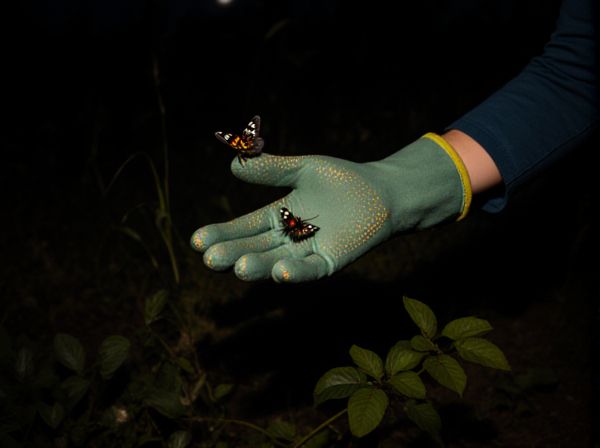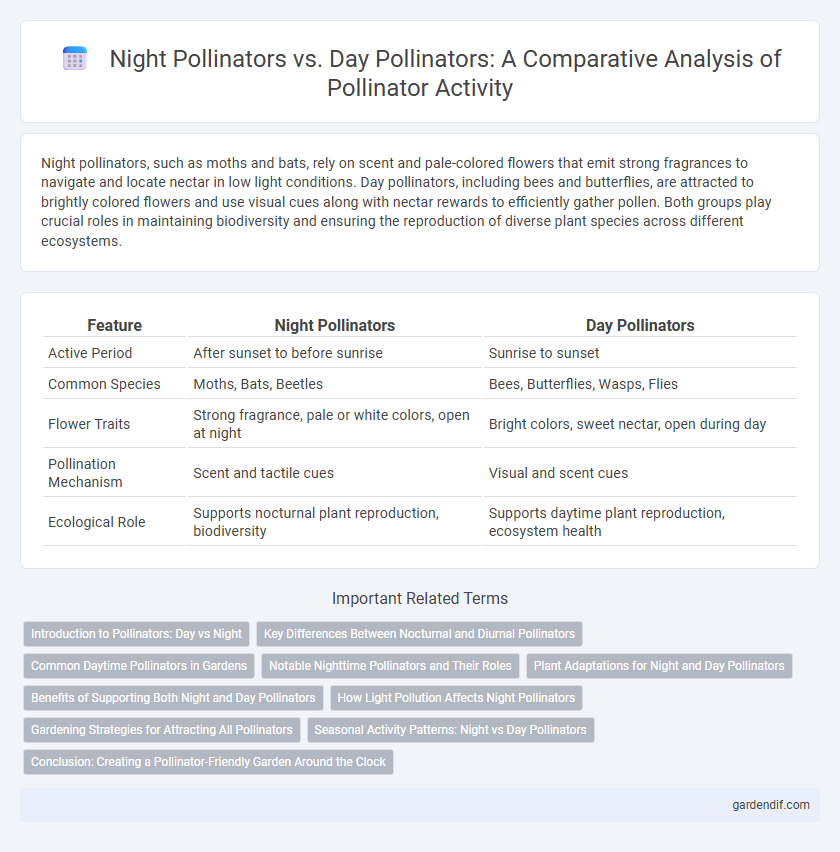
Night Pollinators vs Day Pollinators Illustration
Night pollinators, such as moths and bats, rely on scent and pale-colored flowers that emit strong fragrances to navigate and locate nectar in low light conditions. Day pollinators, including bees and butterflies, are attracted to brightly colored flowers and use visual cues along with nectar rewards to efficiently gather pollen. Both groups play crucial roles in maintaining biodiversity and ensuring the reproduction of diverse plant species across different ecosystems.
Table of Comparison
| Feature | Night Pollinators | Day Pollinators |
|---|---|---|
| Active Period | After sunset to before sunrise | Sunrise to sunset |
| Common Species | Moths, Bats, Beetles | Bees, Butterflies, Wasps, Flies |
| Flower Traits | Strong fragrance, pale or white colors, open at night | Bright colors, sweet nectar, open during day |
| Pollination Mechanism | Scent and tactile cues | Visual and scent cues |
| Ecological Role | Supports nocturnal plant reproduction, biodiversity | Supports daytime plant reproduction, ecosystem health |
Introduction to Pollinators: Day vs Night
Pollinators play a crucial role in ecosystems by facilitating plant reproduction through pollen transfer, with distinct groups active during day and night. Day pollinators such as bees, butterflies, and hummingbirds rely on visual cues and bright flowers, whereas night pollinators including moths, bats, and certain beetles use olfactory signals and pale or night-blooming flowers. Understanding the behavioral and physiological adaptations of these diurnal and nocturnal pollinators reveals their complementary roles in biodiversity and agricultural productivity.
Key Differences Between Nocturnal and Diurnal Pollinators
Nocturnal pollinators, such as moths and bats, operate in low-light conditions and rely heavily on scent and tactile cues to locate flowers with strong fragrances and pale or white colors for better visibility at night. Diurnal pollinators, including bees and butterflies, utilize visual signals like bright colors and UV patterns to find nectar during daylight hours. The key differences lie in their sensory adaptations, activity periods, and the types of flowers they pollinate, contributing to diverse ecological roles and pollination efficiency.
Common Daytime Pollinators in Gardens
Common daytime pollinators in gardens include bees, butterflies, and hoverflies, which are highly effective in transferring pollen due to their frequent visits to flowers. Bees, particularly honeybees and bumblebees, are the most prolific garden pollinators, attracted by brightly colored flowers and sweet nectar. Butterflies and hoverflies contribute to pollination by targeting a wide variety of flowering plants, supporting biodiversity and the health of garden ecosystems.
Notable Nighttime Pollinators and Their Roles
Notable nighttime pollinators include moths, bats, and certain species of beetles, each playing crucial roles in ecosystems by facilitating the reproduction of nocturnal flowering plants. Moths primarily pollinate flowers that open or emit strong fragrances at night, such as evening primrose and some orchids, while bats contribute to the pollination of large, sturdy flowers like agave and durian through their feeding activities. These nocturnal pollinators support biodiversity and agricultural productivity by enabling plant species that rely on nighttime pollination to thrive and reproduce successfully.
Plant Adaptations for Night and Day Pollinators
Plants pollinated by night pollinators, such as moths and bats, often exhibit pale or white flowers that reflect moonlight for visibility, emit strong, sweet fragrances to attract nocturnal visitors, and produce abundant nectar during nighttime hours. In contrast, plants adapted to day pollinators, like bees and butterflies, display vibrant colors, including blues and yellows, and have UV patterns guiding pollinators to nectar, with scents that are less intense but tailored to daylight activity. These specialized adaptations optimize reproductive success by aligning floral traits with the sensory capabilities and behaviors of their respective pollinators.
Benefits of Supporting Both Night and Day Pollinators
Supporting both night and day pollinators enhances ecosystem resilience by ensuring continuous pollination services across a 24-hour cycle, promoting higher plant biodiversity and agricultural productivity. Night pollinators like moths and bats complement daytime pollinators such as bees and butterflies by targeting different flowers, improving genetic diversity and crop yields. This dual support sustains balanced food webs and fortifies habitats against climate variability and environmental stressors.
How Light Pollution Affects Night Pollinators
Light pollution disrupts the natural behaviors of night pollinators such as moths and bats by interfering with their navigation and feeding patterns, leading to decreased pollination efficiency. Unlike day pollinators like bees and butterflies, nocturnal pollinators rely heavily on natural darkness cues to locate flowers and mates, making them particularly vulnerable to artificial lighting. The decline in night pollination services due to light pollution threatens plant reproduction and biodiversity within ecosystems dependent on these specialized pollinators.
Gardening Strategies for Attracting All Pollinators
Gardening strategies for attracting all pollinators should include planting a diverse array of flowers that bloom both day and night, ensuring continuous food sources for diurnal and nocturnal pollinators like bees and moths. Incorporating night-blooming plants such as evening primrose and night-scented stock attracts moths and bats, while bright, nectar-rich flowers like sunflowers and lavender support daytime pollinators. Providing habitats such as bee hotels and minimizing pesticide use further promotes a balanced ecosystem supporting diverse pollinator populations.
Seasonal Activity Patterns: Night vs Day Pollinators
Night pollinators, such as moths and bats, exhibit peak activity during warmer months when nocturnal flowers bloom, aligning with cooler nighttime temperatures that reduce predation risk. Day pollinators like bees and butterflies are most active in spring and summer, capitalizing on abundant daylight and floral nectar availability. Seasonal shifts in temperature and flower phenology drive distinct temporal foraging patterns, ensuring efficient pollination across different ecosystems.
Conclusion: Creating a Pollinator-Friendly Garden Around the Clock
Night pollinators such as moths and bats complement the activities of day pollinators like bees and butterflies, ensuring continuous pollination and increased biodiversity. Incorporating night-blooming flowers alongside brightly colored, nectar-rich daytime plants fosters a garden that supports diverse pollinator species throughout the 24-hour cycle. Strategic planting with native species tailored to both nocturnal and diurnal pollinators enhances ecological balance and garden productivity year-round.
Night Pollinators vs Day Pollinators Infographic

 gardendif.com
gardendif.com